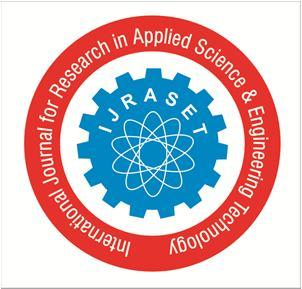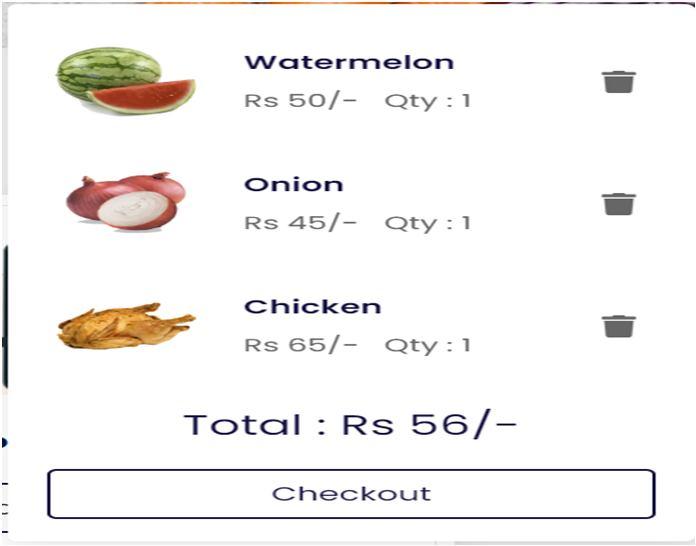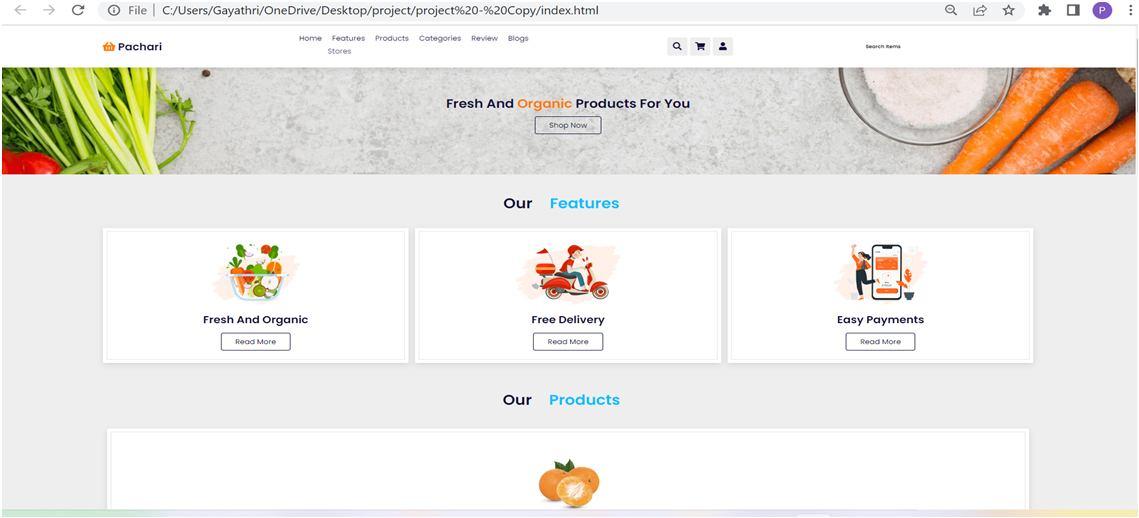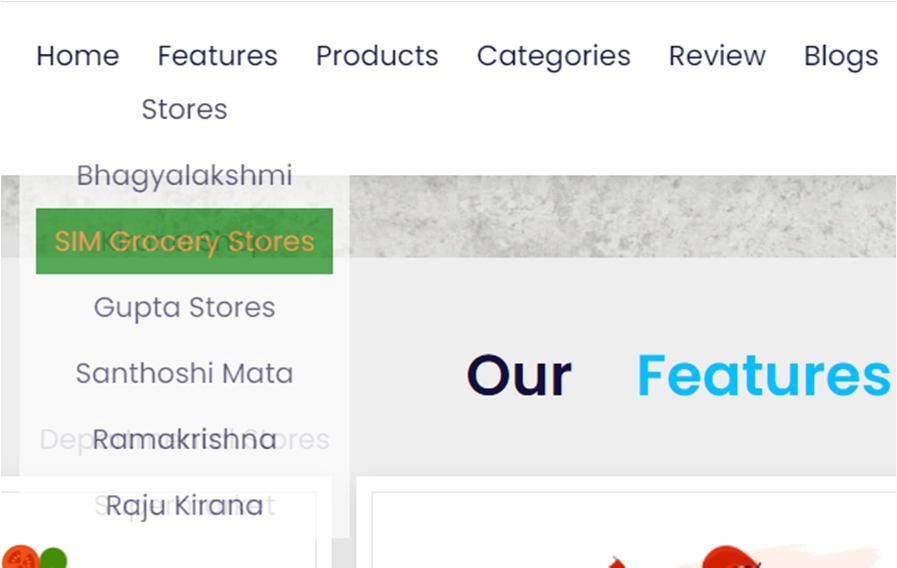

E
ISSN: 2321 9653; IC Value: 45.98; SJ Impact Factor: 7.538 Volume 10 Issue IX Sep 2022 Available at www.ijraset.com
Pachari Market-Basket Analysis-Based on Recommendation System for Grocery
P. Gayathri1 , D. Lalitha Bhaskari21Computer Science & Systems Engineering Department, Andhra University
2Computer Science & Systems Engineering Department, Andhra University

Abstract: Market Basket Analysis, is performed in grocery shopping stores. The goal of this study is to find user requirements for products on a webpage with the best prices and products with auto suggestions for customers. In this paper, an extra feature to the web page is adding store names to the web page for the best experience for customer requirements. After the COVID situation, customers are more concentrated on particular products that they buy from different stores, presenting a store name feature on the webpage, helps the user to know the details of the store and the product maintenance and quality of the store. The experimental output demonstrates that the proposed algorithm can effectively improve the performance of recommendations in terms of the product and auto suggestions for users. Moreover, Market Basket Analysis has been successfully put into service. Keywords: Market-basket Analysis, Grocery shopping, Recommendation system, Auto Suggestion.
I. INTRODUCTION
In these projects, a webpage developed an Online Grocery Store shopping, with the added feature of Store Names which are available at our nearby location products. This feature helps us check the quality of the products, store maintenance of the store, and easy exchange.
In the past years, the culture of shopping, is where we get groceries from different stores through online websites from the store was not so familiar with store quality of supplying products and maintenance and storage of products. It is necessary to select stores for us that are near to us and have faith in the quality of products. It was easy to get on information about the store which is in our surroundings.
Instead of purchasing from unknown stores, you research stores that are near your places that maintain quality and good maintenance of products. Shopping for clothes does not require speedy delivery, but when it comes to groceries, there needs to be speedy delivery and hygiene. It is easy to purchase from our stores where we see the store’s quality by ourselves. Based on user requirements, we provided the name and details of each store that is located near the customer. So, the customer will have an overview of store products in store.
This helps the customer to choose healthy products from nearby stores. In these paper Market Basket Analysis used on the grocery store webpage to perform the best requirements products for meeting customers’ needs by providing automatic suggestions and product offers. That helps users to select products easily and the Apriori algorithm to calculate the frequency of items added to the cart by the customer on the webpage. Apriori algorithm is used for frequent items and brands used by the customer and we perform market basket analysis to remember customer choices and throw offers and combination items to the user.
II. RELATED WORKS
A. Web Page Recommended System
A Customer often cannot obtain appropriate information using a search engine. The research about web pages recommendation is to help user search for information that reflects the user’s intention.
B. Rule Generation Module
The purpose of this module is to train in advance and get the recommended rules, hence the job of the recommended module is to match rules or complete simple arithmetic of rules, which can ensure the effectiveness and feasibility of the recommender system. The structures of rules are different when using different recommended algorithms. The rule structure defined by the FP Growth algorithm is frequent item sets and you can get the matching scores between the food ordered and frequent items to recommend appropriate dishes. However, we define the similarity matrix between items as a rule structure for the CF algorithm, n is the total number of foods.

Science & Engineering Technology (IJRASET

ISSN: 2321 9653; IC Value: 45.98; SJ Impact Factor: 7.538 Volume 10 Issue IX Sep 2022 Available at www.ijraset.com
C. Recommending Suitable Products
To further deliver personalized content to the users, a collaborative filtering system is used. The algorithm retrieves all data for viewing items by all users in the system. Each record is rated by an expert system from 1 to 5. This value indicates the popularity of an item by the user. The algorithm then determines the similarity of the user with other users using the Person correlation coefficient. It takes value from 1 to 1. The value of 1 indicates that the vector items are completely different from each other, the value 1, on the contrary that the vectors item.
III. PROPOSED SYSTEM
A. System Architecture

The architecture of the proposed system is illustrated in Figure it consists of two portions: the recommendation system and the Apriori algorithm for frequent items.
Start
User login Search Product Get product with store name Get recommendat ion on the product after first
B. User Login
Generate candidate item set








Get frequent item sets Generate strong Rule
The user login to the website by registered email and password, user search for the product in the search bar and select the products from the site and add the products to the user cart.
C. Product by store name
The Product displays with the store name for the customer. Users can check store names by locations of their surrounding stores and select product from a particular store and get home delivery. Users can pay through Internet banking or cash on delivery.
D. Recommendations on customer choice
The customer gets auto suggestions on products without searching for the products. Here the system remembers the customer choice and updates products and offers on particular products. These help the user to get an update on products, different offers, and ratings of products on site.
Factor
Factor
E. Generating Frequent Item sets
Journal for Research in Applied Science & Engineering Technology (IJRASET)

ISSN: 2321 9653; IC Value: 45.98; SJ Impact Factor: 7.538 Volume 10 Issue IX Sep 2022 Available at www.ijraset.com
The system Generates the frequent item sets by user choice and items that customer purchase regularly. It helps the store manager to know about the frequent item purchased by different customers. So, they can keep updating products with offers. Generating frequent item sets uses both customer and store management.
F. Generating Store Apriori Rule
Post Generating item sets we apply the Apriori rule on Item sets by the Lift formula by confident value and support values. The aim is to find coupling of items that are often bought jointly, which we call frequent item sets. The practical term for the domain is Frequent Itemset Mining of data. Lift = P (X ꓵ Y) / P(X) * P(Y)
IV. METHODOLOGY
previous papers have mostly focused on web page modeling and listing of products on sites, due to this issue, here we develop a system based on user requirements.
Input: Grocery store
Output: Products with store name and auto recommendation for the


Step1: User login to web page.
Step2: User searching for the product.
Step3: Displaying product with store names.
Step4: System remembers user choice of products.
Step5: System provide auto suggestions to user regularly.
Fig: Algorithm systems

A. Loading information about a new user
In the first step, a new user is created. For the proposed system the following data are stored during the registration of a new user: personal information (name and surname), login information, birth date, email, address, and favorite categories of products.
B. Recommending Suitable Products after the first Login
The prerequisite for this step is that the new user after login the customer purchases products of the customer’s choice. This makes the algorithm able to determine customer choices. The system remembers the customer choices and repeats the customer choice products. The result is a set of P users who have different interests in products the systems show individual choice products for them.
are Reserved | SJ Impact Factor 7.538 | ISRA Journal Impact Factor 7.894 |
for Research in Applied Science & Engineering Technology (IJRASET)

ISSN: 2321 9653; IC Value: 45.98; SJ Impact Factor: 7.538 Volume 10 Issue IX Sep 2022 Available at www.ijraset.com
C. Recommending suitable products
To further deliver personalized content to the users, a collaborative filtering system is used on the webpage. Each item can be ranked more than once because it was viewed by more similar products by users. In this case, the algorithm works with the highest predictive value of interest. Finally, all items are sorted from the highest prediction of interest and are recommended to the user.
D. Evaluating the Popularity of Items using an Expert System
During the user's visit to the online store, the system stores information about the date and time of item viewing, user ID, item ID, and category ID. The collaborative approach requires that each item viewed is evaluated by the user to determine the popularity of an item that the user purchase regularly. We are using an expert system to evaluate user choices. For the items purchased by user, the system remembers the user choice and requirements of different users
V. RELATED RESULTS
1) User needs to Enter customer login details on the page
2) Design of the page with features and products.
Fig1: user login details

Fig2: Page overview
3) List of the products added to the cart and total cost of the products.

Fig: selected products in the cart


Factor
Factor 7.894
& Engineering Technology (IJRASET

ISSN: 2321 9653; IC Value: 45.98; SJ Impact Factor: 7.538 Volume 10 Issue IX Sep 2022 Available at www.ijraset.com
Fig: List of store names

VI. CONCLUSION

In this paper, the market basket analysis recommender system for the online store was proposed. The recommender system uses a recommendations pattern for recommending suitable items and an expert system for evaluating the user requirement of items. The system also proposes an algorithm for showing items from similar users after the first login to decrease the effect of searching for items.
REFERENCES
[1] Adomavicius G., Tuzhilin A. Expert driven validation of rule based user model in personalization application Data Mining and knowledge Discovery, Vol 5
[2] Mosbacher B. Data mining for web personalization. In The adaptive web. Springer Berlin Heidelberg, 2007. for web personalization.
[3] Van Metermen R., Van Someren M. Using content based filter in for a recommendation. In Proceedings of the Machine Learning in the New Information Age: Monet/ECML 2000 Workshop.
[4] Sarwar B., Karypis G., Konstan J., Rield J. Item based collaborative filtering recommendation algorithms. In Proceedings of the 10th international conference on World Wide Web
[5] Perkowitz M., Etzioni O. Towards adaptive web sites: Conceptual framework and case study. Artificial Intelligence, Vol 118.

